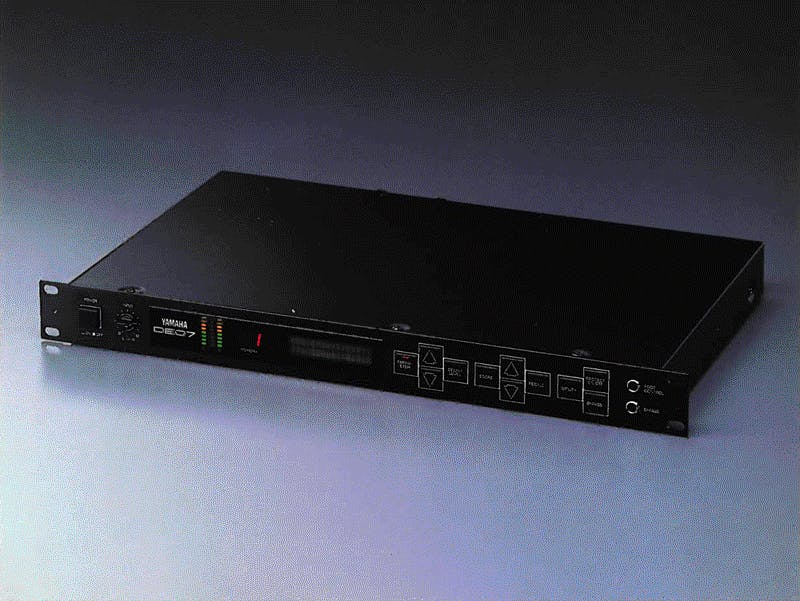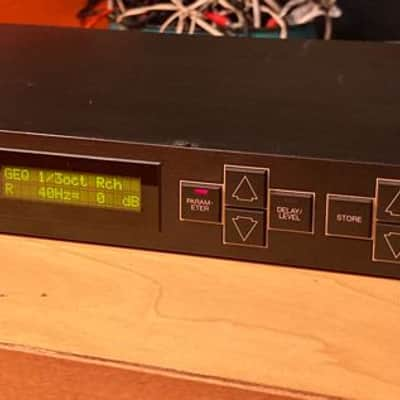1987 (Nov.)
Initially sold for ¥150,000
Equalization is the most widely sued form of "signal processing" in all sound-related fields. Equalization requirements, however, are totally application-dependent, encompassing a limitless range of response configurations. The extraordinary Yamaha DEQ7 Digital Equalizer has been designed to effectively cover every audio equalization requirement in virtually any application.
In one compact rack-mount unit the DEQ7 offers every useful graphic equalizer configuration, versatile tone-control type equalization, precision parametric EQ configurations, extremely flexible bandpass and band rejection filters, unique "dynamic" filters controlled by LFO or manually with a foot switch.
All the basic EQ configurations are stored in 30 preset memory locations, and 60 RAM memory locations are provided to store your own EQ settings for instant recall whenever they are needed. But the DEQ7's broad programmability is just the beginning of its digital story. All internal signal processing in the DEQ7 is in the digital domain. The DEQ7 delivers high quality sound plus the absolute equalization precision and stability that only digital processing can achieve.
For recording, sound reinforcement, broadcast, A/V production, acoustic control and virtually any other professional sound application, the great detail and flexibility offered by the DEQ7 is all managed through a very restricted amount of buttons and a small LCD screen, which albeit being very precise they're surely not as intuitive and quick to use as physical faders.
Features
- Graphic EQ (GEQ) Programs
The DEQ7's GEQ programs provide 18dB of boost or cut. The four EQ configurations include: 1-octave filters (10 bands), 2/3 octave filters (14 bands), 1/2-octave filters (17 bands), and 1/3-octave filters (27 bands). All programs are stereo with the exception of the 27-band 1/3 octave configuration. Both a left channel and a right-channel version of the latter are provided, so two DEQ7's can be combined (using the direct digital inputs and outputs if desired) to provide a full stereo implementation. - Parametric EQ (PEQ) Programs
The "PEQ (4+4)" programs are versatile 4-band parametric equalizers. Each band offers independent center-frequency control in 1/12-octave steps over a 20Hz–16kHz frequency range, 18dB of boost or cut, and Q (bandwidth) control from 0.1 to 10. The "PEQ+SHELV" program is configured as a 2-band parametric equalizer plus variable low and high shelving equalizers. - Tone Control Programs
The "L=R" and "L/R" versions of the tone control program offer bass/treble-type tone control similar to that found on home audio equipment. The bass range rolloff frequency is 200Hz and the treble rolloff is at 5kHz, and each range can be boosted or cut by up to 18dB. The "TONE CONT. NOTCH" program provides a more sophisticated bass/treble tone control system. In addition to independent left and right channel parameters, the bass range rolloff frequency can be varied from 20Hz to 1.2kHz, and the treble rolloff can be varied from 800Hz to 16kHz. As with the other "NOTCH" programs, a variable high-pass filter, variable low-pass filter and three-band notch filter are included. - Band Pass & Band Rejection Filter Programs
These are extremely versatile bandpass and band rejection filters that permit the creation of virtually any type of response by combining variable high-pass and low-pass filters. Both the frequency and the slope of the high-pass and low-pass filters are variable. - Dynamic EQ & FIlter Programs
These programs create a wide range of sweeping peak-EQ or filter effects. In the "DYN. PEQ" programs the gain of the filter peak can be set to 6, 12 or 18dB, and the Q (bandwidth) of the filter response can be set to low or high. The "DYN. FILTER" programs offer a choice of filter types: low-pass, high-pass, bandpass 1 (1-octave bandwidth). The slope of the filter response can be set to 12 or 24dB/octave. In both programs a rising sweep (increasing frequency) or falling sweep (decreasing frequency) may be selected. Both dynamic EQ programs are provided with three different control implementations: in the "FC" programs the sweep is controlled either by a foot controller, or by a MIDI "foot control" or "note-on" message. In the "LEVEL" programs the sweep is triggered by the input signal. And in the "LFO" programs an internal low-frequency oscillator sweeps the filter automatically.




